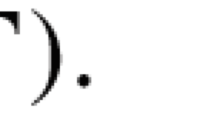Abstract
This is the continuation of part I, which was published in the September, 1963, issue ofThe Bulletin. Section 5 treats the special case in which the left absorbing barrier recedes to −∞, leaving essentially only one barrier at a finite distance Λ (>0) from the origin. The eigenfunctions are now parabolic cylinder functions. The limiting cases Λ→+∞ and Λ→0 are also considered. Though meaningless for practical applications to our problem, they are of interest, mathematically, because the Green’s function for the solution of the Fokker-Planck equation assumes a particularly simple form. In section 6 we study, by means of an example, how the “force of mortality” may vary with time before attaining its final asymptotic value. Section7, still dealing with only one absorbing barrier, shows that our results for “strong homeostasis” are identical with those derived by Chandrasekhar for the escape of particles through a potential barrier in the limiting case of quasi-static flow. Precise conditions are given for the validity of both the quasi-static and the Smoluchowski approximations to the Fokker-Planck equation. Finally, in section 8, a brief mention is made of Gevrey’s method for the solution of parabolic partial differential equations.
Similar content being viewed by others
Literature
Buchholz, H. 1953.Die konfluente hypergeometrische Funktion. Berlin: Springer.
Chandrasekhar, S. 1943. “Stochastic Problems in Physics and Astronomy.”Rev. Mod. Phys.,15, 1–89.
Doetsch, G. 1930. “Integraleigenschaften der Hermiteschen Polynome.”Mathem. Zeitschrift,32, 587–599.
Feller, W. 1952. “The Parabolic Differential Equations and the Associated Semigroup of Transformations.”Ann. Math.,55, 468–519.
Gevrey, M. 1913. “Sur les équations aux dérivées partielles du type parabolique.”Journal de mathématiques pures et appliquées,9(6), 305–475.
Goursat, E. 1942.Cours d’analyse mathématique. 5th ed., Tome III. Paris: Gauthier Villars.
Kowallik, U. 1929. “Entwicklung einer willkürlichen Funktion nach Hermiteschen Orthogonalfunktionen.”Mathem. Zeitschrift,31, 498–518.
Kramers, H. A. 1940. “Brownian Motion in a Field of Force and the Diffusion Model of Chemical Reactions.”Physica,7, 284–304.
Myller-Lebedeff, W. 1907. “Die Theorie der Integralgleichungen in Anwendung auf eine Reihentwicklung.”Mathematische Annalen,64, 388–416.
Sacher, G. A., and E. Trucco. 1962. “The Stochastic Theory of Mortality.”Ann. N. Y. Acad. Sci.,96, 985–1007.
Tricomi, F. G. 1954.Funzioni Ipergeometriche Confluenti. Roma: Edizioni Cremonese.
Uhlenbeck, G. E. and L. S. Ornstein. 1930. “On the Theory of Brownian Motion.”Phys. Rev.,36, 823–841.
Whittaker, E. T. and G. N. Watson. 1947.A Course of Modern Analysis. American ed., Cambridge: University Press; New York: Macmillan Co.
Author information
Authors and Affiliations
Rights and permissions
About this article
Cite this article
Trucco, E. On the Fokker-Planck equation in the stochastic theory of mortality: II. Bulletin of Mathematical Biophysics 25, 343–366 (1963). https://doi.org/10.1007/BF02476563
Received:
Issue Date:
DOI: https://doi.org/10.1007/BF02476563




